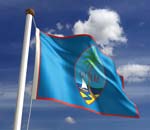
The First-responder Portal
Common platform allows complete communications
- By Kevin Freiburger
- Mar 05, 2010
In examining its emergency response
program, the Guam government
wanted to ensure partnership and
leadership. In other words, officials
wanted to promote a collaborative environment
for sharing information,
resources, assistance and expertise to
enhance the security environment.
A common platform was proposed
to provide a commonality for public
safety, special districts, the Guam
government, the private sector and the
public to collaborate, communicate and
share information. The goal was to better
prevent, deter, respond to and recover
from cyber attacks and incidents of
terrorism involving the use of chemical,
biological, radiological, nuclear and explosive
weapons.
"Interoperable systems would not
only provide critical information in a
timely fashion to those who need it, but
it was equally critical to provide this
information in an easy-to-use format,"
said Ben Comacho of the Guam Department
of Revenue and Taxation.
ScreenCheck's public safety and firstresponder
portal provides opportunities
to test the vendor's capabilities to identify
and respond to a terrorist event.
In the Know
It was necessary to have a system that
addresses the single most critical gap in
preparedness, prevention and recovery
by dramatically improving the sharing
of information and communications
across the island's disciplines.
"The idea was to reduce Guam's
vulnerability to terrorism and building
infiltration by tracking critical information
in a meaningful format," said Michael
Fox, president of ScreenCheck.
"It is important that citizens, government,
hospitals and businesses at all
levels effectively respond in the events
of a terrorist attack or natural disaster
and secure its facilities."
By introducing its public safety and
first-responder portal, ScreenCheck
made sure there was a distributed entry
and display of public health surveillance
system data.
The portal helps to:
- Establish a terrorism intelligence
and early warning system by providing
a GIS foundation to display
real-time data from remote sensing
devices.
- Create and maintain a regional database
for CERT and citizen corps
councils.
- Provide access and authorizations
functionality that are a requirement
of a cyber security program.
- Provide connectivity and collaboration
required to establish or integrate
emergency operations centers.
Specifically, the proposed PSFRP
Guam implementation was comprised
of a system that implemented a NIMScompliant
structured product for meeting
national preparedness guidelines
for Guam.
Tools of the Trade
Some of the key components of building
a first-responder portal meant providing
an online method of entering,
evaluating and producing first-responder
credentials. It also was necessary to
provide a GIS mapping and integration
system for key locations on the island
with methods and processes for applying
critical information about them.
A Web database, handheld devices,
procedures, preparedness rules and
applications enables officials to track
critical information before, during
and after a terror event or disaster.
This also includes patient, refugee, displaced
citizen, student and equipment
ID and tracking.
ScreenCheck officials also responded
by providing tools to reduce the
likelihood of terror events by identifying
key areas within the island that
require monitoring, as well as integrating
with multiple vendor access
control systems for Guam's critical
government facilities. Implementation
of a strong first-responder system
will allow for credentialing, recording,
documenting, training and tracking
first-responder data.
Established criteria also includes
Real ID/PASS ID-compliant ID enhancements
for state and local government,
where credentials could be used
by first responders, government officials
and military. Police, fire and rescue, hospitals,
medic provider groups and participating
consultants and vendors were
then able to develop a public safety portal
for island-wide, interdisciplinary incident
crisis management and preparedness
and response and recovery.
"This platform is specifically designed
to meet the strategic objectives
of the Guam homeland security strategic
plan for partnership, leadership
and communication," Comacho said.
"The PSFRP will provide a secure
portal platform to facilitate the sharing
of information across jurisdictions
and among all functional disciplines.
"For the first time ever, public safety
agencies, special purpose districts and
the private sector will be able to share
event status information for terrorist
events, view, catalog and track damage,
patient status and communicate the
event management plan during a terrorist
event."
The two defined applications include
ScreenCheck's cards online portal, which
provides secure credentialing, badging,
patient triage and tracking, and the
tactical planner program that provides
easy-to-use drag-and-drop icons to display
building and site plan information.
This critical information is provided on
a familiar Web access platform. Most
information can be accessed via GIS
display where the user zooms in on the
location or event site, turning to selected
data layers for information.
The Guam PSFRP provides the regional,
interagency, interdisciplinary
secure data platform designed specifi-
cally to exchange information among
users. The portal has a strong firewall
and authentication security features
and, when combined with the system
credentialing, encryption, biometrics,
access and authorization features, the
portal provides the most robust security
available.
This article originally appeared in the issue of .